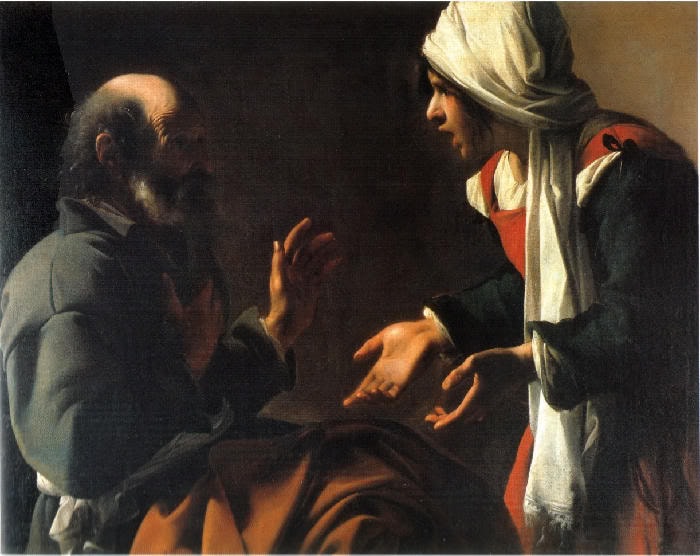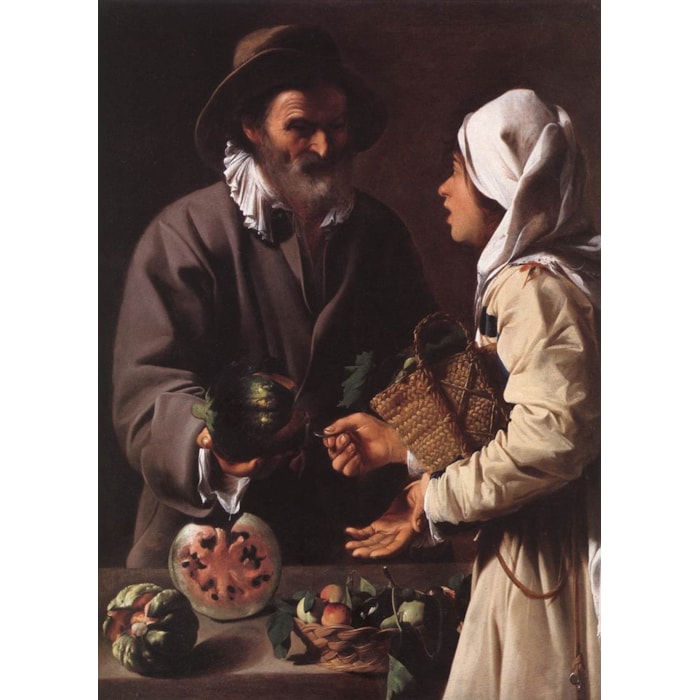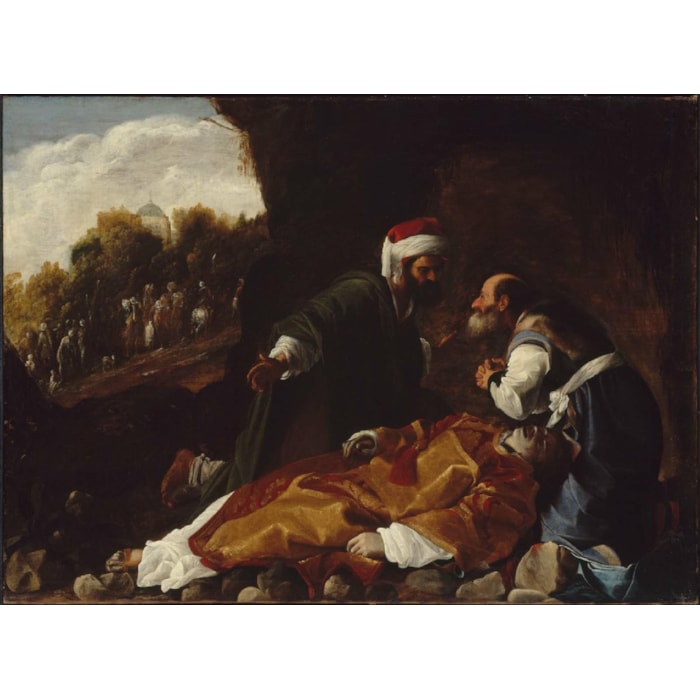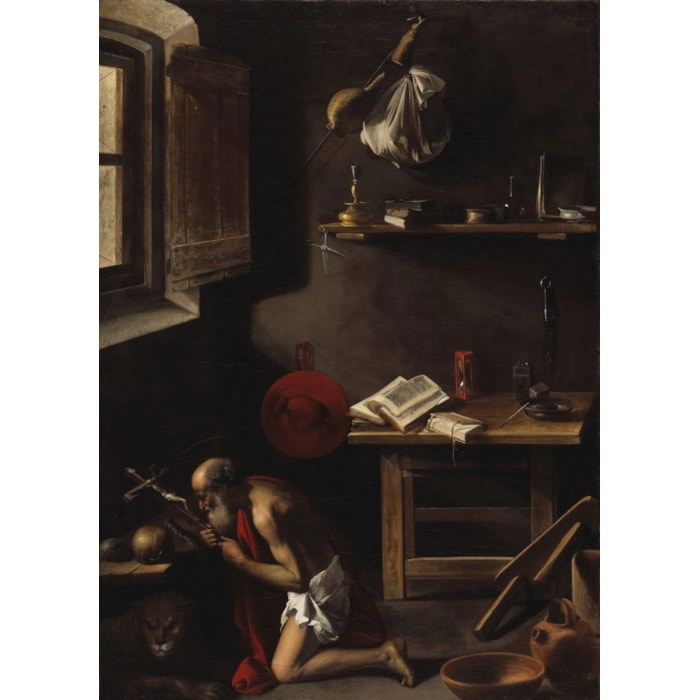Pensionante del Saraceni (Active in Rome between 1610 and c. 1620)
(Active in Rome between 1610 and c. 1620)
Saint JeromeOil on canvas, 25 3/16 x 19 11/16 in (64 x 50 cm)
- PROVENANCE
- LITERATURE
- EXHIBITIONS
- DESCRIPTION
PROVENANCE
With Di Castro, Rome; 1965, Bologna, private collection; 2016, France, private collection.
LITERATURE
-Anna Ottani Cavina, Carlo Saraceni, Milan, 1968, pp. 49-50, p. 68, note 48, figs. 30-31;
-Benedict Nicolson, “The Art of Carlo Saraceni”, The Burlington Magazine, no. 806, May 1970, p. 314;
-R. Ward Bissell, “Anna Ottani Cavina, Carlo Saraceni” (review), The Art Bulletin, vol. 53, no. 2, June 1971, p. 249;
-Anna Ottani Cavina, “La Tour all’Orangerie e il suo primo tempo caravaggesco”, Paragone, 1972, no. 273, pp. 3-23, fig. 10;
- Jean-Pierre Cuzin and A. Brejon de Lavergnée, eds., I caravaggeschi francesi, Rome, Académie de France, Villa Medici, 15 November 1973–20 January 1974, pp. 78-79, no. 20; Paris, Grand Palais, 13 February-15 April 1974, pp. 80-81, no. 21;
-Benedict Nicolson and Christopher Wright, Georges de La Tour, London, 1974, pp. 35-36, fig. 149;
-Benedict Nicolson, Caravaggism in Europe (Second Edition, Revised and Enlarged by Luisa Vertova), 3 vol., Oxford, 1979, I, p. 155, II, fig. 796;
-Anna Ottani Cavina, “Per il ‘Pensionante del Saraceni’”, in Scritti di Storia dell’arte in Onore di Federico Zeri, Venice, 1984, p. 614, note 8;
-Gianni Papi, “Un’apertura sul soggiorno italiano di Jacob Van Oost il Vecchio”, Studi di Storia dell’arte, 1, 1990, pp. 175, 180, note 20;
-Gianni Papi, in Caravaggio y la pintura realista europea, exh. cat., Barcelona, Museu Nacional d’Art de Catalunya, 10 October 2005-15 January 2006, p. 230, under no. 53, p. 422;
-Gianni Papi, in G. Papi, ed., La ‘schola’ del Caravaggio. Dipinti della collezione Koelliker, exh. cat., Ariccia, Palazzo Chigi, 13 October 2006 – 11 February 2007, p. 112, under no. 28;
-David Franklin and Stephen Gritt, “A New Painting for Ottawa by the Pensionante del Saraceni”, National Gallery of Canada Review (Revue du musée des Beaux-Arts du Canada), VI, Ottawa, 2008, p. 5;
-Maria Giulia Aurigemma, “Il Pensionante del Saraceni (attivo nel secondo decennio del XVII secolo)”, in C. Strinati and A. Zuccari, eds., I Caravaggeschi. Percorsi e protagonisti, , Geneva and Milan, 2010, II, pp. 558, 561, note 38;
-Michele Nicolaci, “Il ‘Pensionante del Saraceni’. Storiografia di un enigma caravaggesco”, in Maria Giulia Aurigemma, ed., Carlo Saraceni.Un Veneziano tra Roma e l’Europa 1579-1620, exh. cat., Rome, Palazzo di Venezia, 29 November-2 March 2014, p. 374, fig. 3;
-Valeria Di Giuseppe Di Paolo, “Note sulle opere disperse di Carlo Saraceni e qualche sottrazione”, in Maria Giulia Aurigemma, ed., Carlo Saraceni. Un Veneziano tra Roma e l’Europa 1579-1620, exh. cat., Rome, Palazzo di Venezia, 29 November-2 March 2014, pp. 378, 383, note 7.
EXHIBITIONS
I caravaggeschi francesi, Rome, Académie de France, Villa Medici, 15 November 1973 – 20 January 1974; Paris, Grand Palais, 13 February -15 April 1974. Catalogue ed. by Jean-Pierre Cuzin and Arnauld Brejon de Lavergnée.
DESCRIPTION
The Saint Jerome before us joins a limited group of paintings by this enigmatic artist, assembled by Roberto Longhi (1943)1 under the name “Il Pensionante del Saraceni”. Scattered between Europe and North America, these comprise The Denial of Saint Peter (Rome, Vatican Picture Gallery; fig. 1)2, The Fruit Vendor and a Servant (Detroit Institute of Arts; fig. 2), The Poultry Seller (Madrid, Prado Museum; fig. 3), The Cook (Florence, Galleria Corsini), with the later addition of the Still Life with Watermelon (Washington, National Gallery of Art), our Saint Jerome, and Saint Stephen Mourned by Gamaliel and Nicodemus (Boston, Museum of Fine Arts; fig 4), which is probably the earliest of these pictures. A recent addition to this catalogue is the ambitious Penitent Saint Jerome in his Study (Ottawa, National Gallery of Canada; fig 5), a work of high quality that can be securely placed in Rome in the period 1610/15-1620; this is also proved by the inventories of the important Roman collection of Cardinal Giacomo Sannesi (died 1621), which list the Mourning of Saint Stephen in Boston and the Fruit Vendor in Detroit.
The name “Pensionante” (lodger, or tenant) of Saraceni indicates a proximity of style to the Venetian painter Carlo Saraceni (1579-1620) when the latter was living in Rome, between 1598 and 1619. Saraceni’s activity in the Eternal City was central to the development of the Caravaggesque movement, and he had a flourishing workshop. He housed several colleagues under his roof, including Jean le Clerc (1586-1633) from Lorraine, and was clearly a francophile, dressing alla francese and speaking French. His version of Caravaggio’s language was a mellow one, nourished by Venetian painting, and this left its mark on the key works by the Pensionante, whose approach was less dramatic than that of Caravaggio himself (1571-1610).
Beginning with Roberto Longhi’s text of 1943 there has been a consensus regarding the French character of this artist. The presence du Saint Jerome in the exhibition of French Caravaggesque painters held in Rome and Paris in 1974-1975 in no way diminished this opinion, although the curators finally recognized that “this painter retains his mystery”. In his concurrent monograph on Georges de La Tour, Benedict Nicolson underlined the relationship with France and a stylistic harmony with the works of the great master from Lorraine, especially in the red-orange colour range, here found in the robe and the hourglass case, and in his interest in still life. More recently, scholars have accepted this Saint Jerome as part of the painter’s oeuvre. Gianni Papi has put forward some ideas regarding his nationality, considering that some works suggest Flemish origins, while others are tinged with the influence of Emilian art. Our artist’s place of birth remains an open question to this day.
The artist is close to his subject here. Saint Jerome, one of the four Doctors of the Latin Church, is portrayed bust-length, seated at his desk as he studies the open Bible before him, and puts pen to paper – the true scholar. In the foreground, the skull and hourglass stand for penitence as practised by the holy man in his retreat in the wilderness. A very similar red hourglass case is found on Jerome’s desk in the Ottawa painting, where he is shown kneeling in devotion.
As regards the features of the venerable saint, parallels can be drawn with the physical type found in the Fruit Vendor in Detroit and the Poultry Seller in Madrid, two paintings included in the Pensionante’s oeuvre when it was first established. The connection between our artist and Carlo Saraceni is further supported by the presence of the same model among the central figures in the latter’s Saint Benno Retrieving the Keys of the City of Meissen, the masterpiece of 1617 painted for the church of the German-Dutch community in Rome, Santa Maria dell’Anima.
The soft enveloping light striking the forehead of Saint Jerome creates strong shadows under his hand and in front of the book, where it plunges the skull into penumbral darkness. A few passages of generous impasto on the top of the head and beard emphasize these bursts of light. The composition, set against a dark, half-lit background, is inspired by the painting of the 1610s, revealing the Pensionante’s prominent role in the evolution of caravaggismo, “connected with the mature Saraceni” – as Longhi wrote – “and superior to him, pictorially”.
Notes:
1- Roberto Longhi, “Ultimi studi sul Caravaggio e la sua cerchia”, Proporzioni, 1943, I, pp. 5-63. See also Anna Ottani Cavina, Carlo Saraceni, Milan, 1968, pp. 50, 68, note 48: this Saint Jerome is published there for the first time.
2- The Denial of Saint Peter is known in a number of versions, the prime iteration being the canvas in the Vatican Picture Gallery, while that in the National Gallery of Ireland, Dublin comes in second position. Another is in the museum of the Charterhouse of Douai, sometimes still considered by recent scholars (and the Douai museum) as original: see Jean-Patrice Marandel, in Corps et Ombres. Caravaggio et le caravagisme européen, exh. cat. (Toulouse, Los Angeles and Hartford, 2012-2013, ed. by Michel Hilaire and Axel Hémery, pp. 126-127, no. 18), although its authorship had already been questioned by Nicolson (see Benedict Nicolson, Caravaggism in Europe, 3 vols.,Oxford, 1979, I, p. 155, under no. 793).














